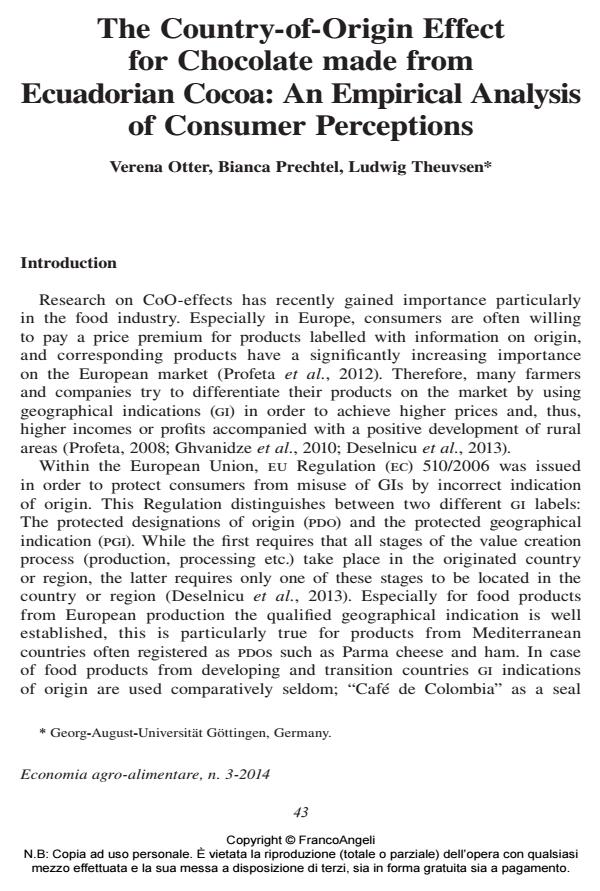The Country-of-Origin Effect for Chocolate made from Ecuadorian Cocoa: An Empirical Analysis of Consumer Perceptions
Titolo Rivista ECONOMIA AGRO-ALIMENTARE
Autori/Curatori Verena Otter, Bianca Prechtel, Ludwig Theuvsen
Anno di pubblicazione 2014 Fascicolo 2014/3
Lingua Inglese Numero pagine 18 P. 43-60 Dimensione file 149 KB
DOI 10.3280/ECAG2014-003005
Il DOI è il codice a barre della proprietà intellettuale: per saperne di più
clicca qui
Qui sotto puoi vedere in anteprima la prima pagina di questo articolo.
Se questo articolo ti interessa, lo puoi acquistare (e scaricare in formato pdf) seguendo le facili indicazioni per acquistare il download credit. Acquista Download Credits per scaricare questo Articolo in formato PDF

FrancoAngeli è membro della Publishers International Linking Association, Inc (PILA)associazione indipendente e non profit per facilitare (attraverso i servizi tecnologici implementati da CrossRef.org) l’accesso degli studiosi ai contenuti digitali nelle pubblicazioni professionali e scientifiche
The indication of country of origin on food products is of growing importance and offers potentials for product differentiation to, among others, cacao producers from countries in the developing and transition stages. In this study the importance of country-of-origin (CoO) effects on the quality perception of chocolate among German consumers is examined using the example of Ecuadorian cacao. The quality perception of chocolate is the result of a complex perceptual process influenced by extrinsic and intrinsic product attributes, country images, socio-demographic and psychographic characteristics of the consumer and situational factors such as place of purchase. Based on this conceptual framework, an online survey has been conducted with 205 German chocolate consumers. ols regression analysis revealed a strong CoO-effect on the purchase of Ecuadorian chocolate. These findings have implications for management.
Parole chiave:Country-of-Origin-Effect, Cacao, Chocolate, Ecuador, Quality Perception, Geographical Indication
Jel codes:D11, D12, D18, M31
- Evaluación de la sostenibilidad socio-económica en fincas productoras de cacao en el centro-norte de Ecuador: una propuesta de estrategias inter-organizacionales Carlos Moreno Miranda, Mayra Liliana Paredes , Jenny Elizabeth Escobar Guerrero, José Isaac Molina Sánchez, in Acta Agronómica /2021
DOI: 10.15446/acag.v70n2.85876 - Willingness to pay for environmental effects of agroforestry systems: a PLS-model of the contingent evaluation from German taxpayers’ perspective Verena Otter, Josef Langenberg, in Agroforestry Systems /2020 pp.811
DOI: 10.1007/s10457-019-00449-6 - Quality differentiation of cocoa beans: implications for geographical indications Carlos Eduardo Hernandez, Leonardo Granados, in Journal of the Science of Food and Agriculture /2021 pp.3993
DOI: 10.1002/jsfa.11077
Verena Otter, Bianca Prechtel, Ludwig Theuvsen, The Country-of-Origin Effect for Chocolate made from Ecuadorian Cocoa: An Empirical Analysis of Consumer Perceptions in "ECONOMIA AGRO-ALIMENTARE" 3/2014, pp 43-60, DOI: 10.3280/ECAG2014-003005